4, Experimental conclusion
1. Experimental task 1
- task1.asm source code
1 assume cs:code, ds:data 2 3 data segment 4 x db 1, 9, 3 5 len1 equ $ - x 6 7 y dw 1, 9, 3 8 len2 equ $ - y 9 data ends 10 11 code segment 12 start: 13 mov ax, data 14 mov ds, ax 15 16 mov si, offset x 17 mov cx, len1 18 mov ah, 2 19 s1:mov dl, [si] 20 or dl, 30h 21 int 21h 22 23 mov dl, ' ' 24 int 21h 25 26 inc si 27 loop s1 28 29 mov ah, 2 30 mov dl, 0ah 31 int 21h 32 33 mov si, offset y 34 mov cx, len2/2 35 mov ah, 2 36 s2:mov dx, [si] 37 or dl, 30h 38 int 21h 39 40 mov dl, ' ' 41 int 21h 42 43 add si, 2 44 loop s2 45 46 mov ah, 4ch 47 int 21h 48 code ends 49 end start
- Operation results
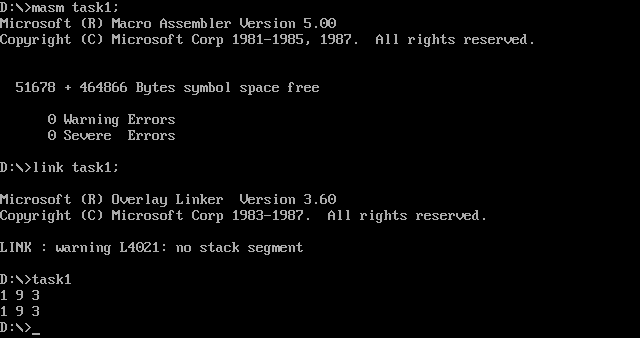
- Question 1
Jump displacement: according to the jump instruction E2F2, F2 is the complement, and the decimal number corresponding to the original code is - 14, so the displacement is - 14.
For the CPU, when executing the loop instruction, the current IP address is 0019. After adding the number of bytes (2 bytes) of the instruction, it is 001B. After adding the displacement - 14, the jump address is 000D, that is, the offset address of the instruction after label s1.
- Question 2
Jump displacement: according to the jump instruction E2F0, F0 is the complement, and the decimal number corresponding to the original code is - 10, so the displacement is - 10.
For the CPU, when executing the loop instruction, the current IP address is 0037. After adding the number of bytes (2 bytes) of the instruction, it is 001B. After adding the displacement of - 10, the jump address is 0029, that is, the offset address of the instruction after label s2.
- Question 3
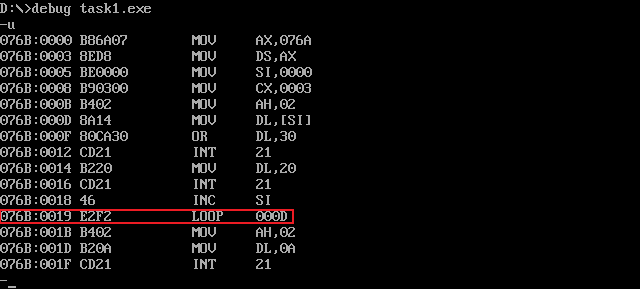

2. Experimental task 2
- task2.asm source code
1 assume cs:code, ds:data 2 3 data segment 4 dw 200h, 0h, 230h, 0h 5 data ends 6 7 stack segment 8 db 16 dup(0) 9 stack ends 10 11 code segment 12 start: 13 mov ax, data 14 mov ds, ax 15 16 mov word ptr ds:[0], offset s1 17 mov word ptr ds:[2], offset s2 18 mov ds:[4], cs 19 20 mov ax, stack 21 mov ss, ax 22 mov sp, 16 23 24 call word ptr ds:[0] 25 s1: pop ax 26 27 call dword ptr ds:[2] 28 s2: pop bx 29 pop cx 30 31 mov ah, 4ch 32 int 21h 33 code ends 34 end start
- Debug screenshot



After analysis, debugging and verification, register (ax)=21H, (bx)=26H, (cx)=067C.
Among them, the call instruction will stack the instruction address in the ip register, so when it comes out of the stack, it is the address of the next instruction after the call instruction, i.e. 0021H, which is assigned to ax.
The call dword instruction will stack the code segment address in cs and the instruction address in ip respectively, so 26H and 067C are assigned to CX and BX respectively when they are out of the stack.
3. Experimental task 3
- task3.asm source code
1 assume ds:data, cs:code 2 3 data segment 4 x db 99, 72, 85, 63, 89, 97, 55 5 len equ $- x 6 data ends 7 8 code segment 9 start: 10 mov ax,data 11 mov ds,ax 12 mov si,0 13 mov cx,len 14 s: call printNumber 15 call printSpace 16 inc si 17 loop s 18 19 mov ax,4c00h 20 int 21h 21 22 printNumber: 23 mov ah, 0 24 mov al, [si] 25 mov bl, 10 26 div bl 27 mov bl,al 28 mov bh,ah 29 30 mov ah,2 31 mov dl,bl;Printer 32 or dl,30h 33 int 21h 34 35 mov dl,bh;Print remainder 36 or dl,30h 37 int 21h 38 ret 39 40 41 printSpace: 42 mov ah,2 43 mov dl,' ' 44 int 21h 45 ret 46 code ends 47 end start
- Screenshot of running test
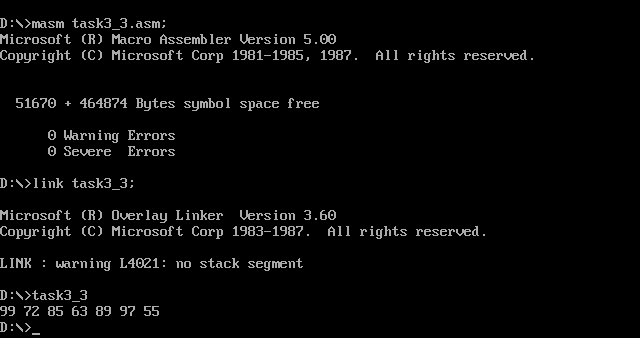
4. Experimental task 4
- task4.asm source code
1 assume cs:code, ds:data 2 3 data segment 4 str db 'try' 5 len equ $ - str 6 data ends 7 8 code segment 9 start: 10 mov ax, data 11 mov ds, ax 12 mov ax,0b800H 13 mov es,ax 14 15 mov si,offset printStr 16 mov ah,2 17 mov bx,0 18 call si 19 20 mov si,offset printStr 21 mov ah,4 22 mov bx,0f00H 23 call si 24 25 mov ah, 4ch 26 int 21h 27 28 printStr: 29 mov cx,len 30 mov si,0 31 s: mov al,[si] 32 mov es:[bx+si],ax 33 inc si 34 inc bx 35 loop s 36 ret 37 38 code ends 39 end start
- Screenshot of running test
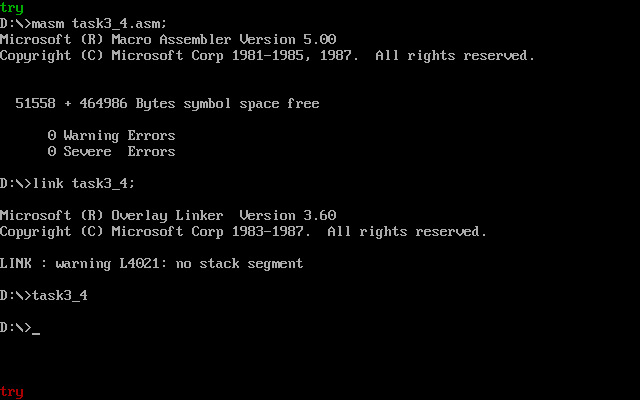
5. Experimental task 5
- task5.asm source code
1 assume cs:code, ds:data 2 3 data segment 4 stu_no db '201983290473' 5 len = $ - stu_no 6 data ends 7 8 code segment 9 start: 10 mov ax, data 11 mov ds, ax 12 mov ax,0b800H 13 mov es,ax 14 15 mov cx,0780H 16 mov ah,10H 17 mov al,' ' 18 mov bx,0 19 20 s: mov es:[bx],ax 21 add bx,2 22 loop s 23 24 mov cx,80 25 mov ah,17H 26 mov al,'-' 27 s1: mov es:[bx],ax 28 add bx,2 29 loop s1 30 31 mov cx,len 32 mov bx,0F44H 33 mov si,0 34 s2: mov al,[si] 35 mov es:[bx],ax 36 inc si 37 add bx,2 38 loop s2 39 40 mov ah, 4ch 41 int 21h 42 43 code ends 44 end start
- Screenshot of running test
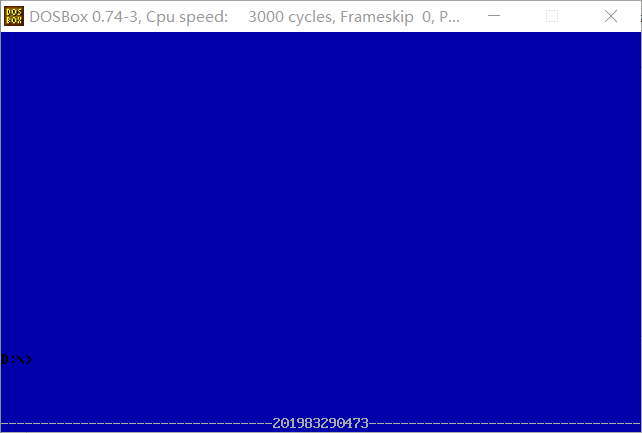
5, Experimental summary
1. This experiment is mainly to try to realize some modular programming, and understand the display memory space more thoroughly.
2. In the confirmatory experiment, it is mainly understood that the last two bits of the machine code of loop instruction are signed displacements, which are given in the form of complement.